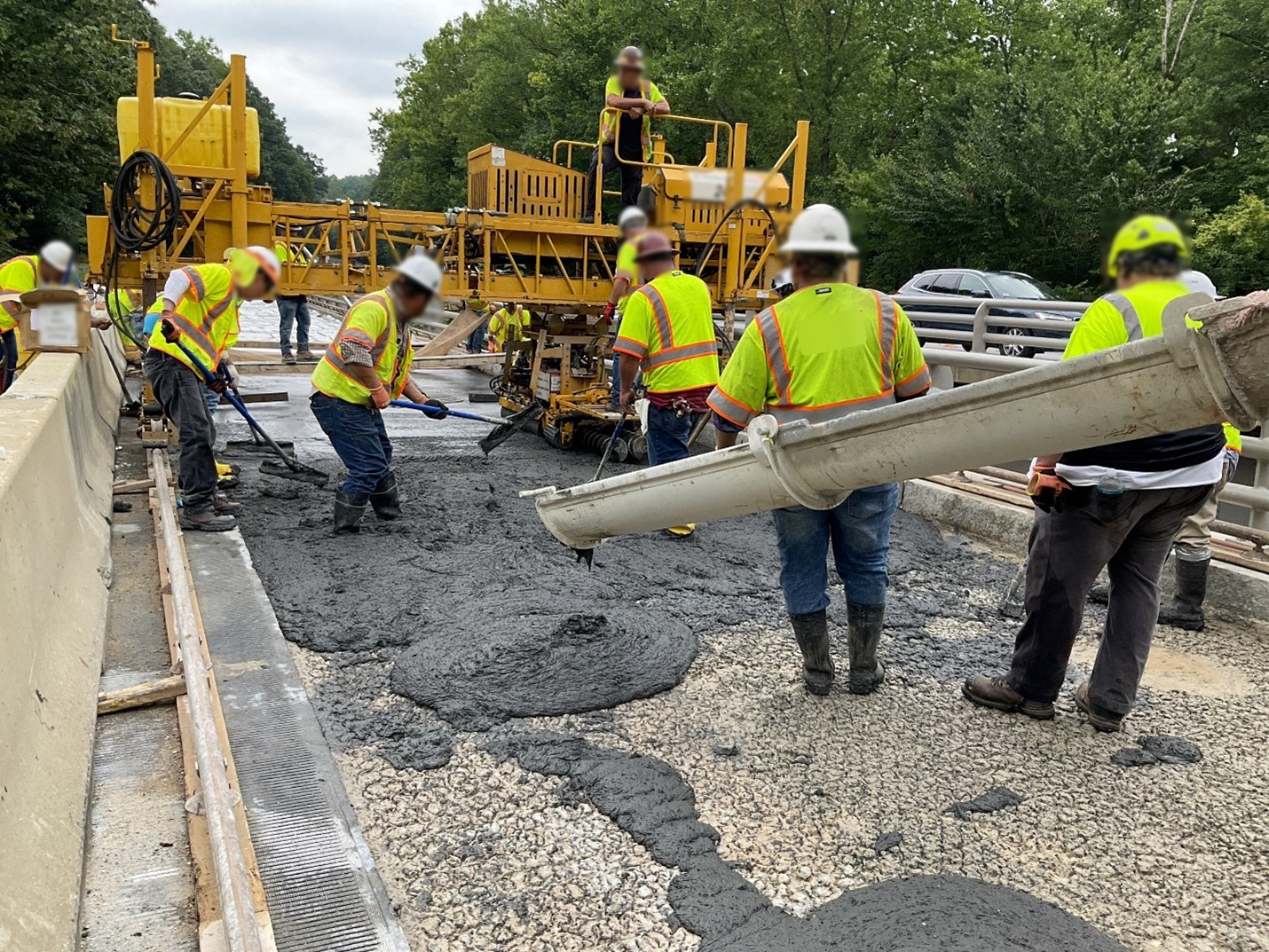February 20, 2025
Innovation of the Month- Ultra-High Performance Concrete
Ultra-high performance concrete (UHPC) overlays enhance the service life of highway structures. UHPC overlays create an armoring layer for a conventional concrete deck, offering very low permeability, good freeze-thaw and abrasion resistance, high strength and stiffness, and a good bond to the substrate concrete. For some bridges, such as those that are heavily-traveled and are showing signs of concrete deck deterioration, UHPC overlays have the potential to have lower life-cycle costs than other overlay options or full deck replacements. These types of overlays have been used in the U.S. since 2016 to rehabilitate existing decks and enhance the service life of new decks.
 UHPC Overlays are a faster and cost-efficient alternative to traditional bridge deck rehabilitation or replacement. (Credit: FHWA)
UHPC Overlays are a faster and cost-efficient alternative to traditional bridge deck rehabilitation or replacement. (Credit: FHWA)One recent UHPC overlay application was by Eastern Federal Lands Highway Division (EFLHD) for four bridges on the heavily traveled George Washington Memorial Parkway near Washington, D.C. The contractor proposed UHPC overlay as a cost-saving alternative to the originally specified overlay option. The primary cost savings stemmed from minimizing schedule delay risks. In addition, the contractor installed the UHPC overlay with their own crew using conventional concrete deck placement equipment, which eliminated the need to rely on a specialty contractor. The UHPC supplier was able to mix the UHPC at a local ready-mix plant and to deliver 5 cubic yard batches to the site in standard ready-mix trucks. The material was placed and finished using a vibrating and oscillating screed. This project exemplified how UHPC overlays can be deployed on high volume routes using conventional construction equipment and techniques.
A recently released TechNote summarizes the experiences of EFLHD and three other entities with recent UHPC overlay installations. The TechNote assembles stakeholder experiences and feedback into several different categories based on the typical steps in the process for constructing UHPC overlays. The feedback from these stakeholders is aimed to help other interested entities successfully implement UHPC overlays, enhancing the performance of the bridge inventory, one bridge at a time.
To learn more about UHPC for bridge preservation and repair, please contact David Garber or Justin Ocel in the FHWA Resource Center, or Ben Graybeal in FHWA Office of Research, Development, and Technology.
NextGen TIM Offers SMART Ways to Use Emergency Warning Lights
Emergency warning lights ahead are a cue to drivers to slow down, move over, and be cautious. The challenge is that there is no national standard for the color, placement, intensity, or flash pattern of emergency warning lights across police, fire, emergency medical services, transportation, and towing vehicles. The Manual on Uniform Traffic Control Devices for Streets and Highways warns that “the use of too many lights at an incident scene can be distracting and can create confusion for approaching road users, especially at night.”
While emergency vehicle lights are not traffic control devices, they do form the basis for important visual communication that affects the way drivers interact with emergency responders stopped at roadway incidents. To make the most effective use of these lighting systems, Responder agencies should consider the following “SMART” emergency lighting aspects- strategic placement, meaningful messaging, automatic features, reduced pattern and intensity, and a tiered approach.
Take a deeper dive into each of these aspects in a new FHWA tech brief. Discover the benefits of each aspect and learn how you can incorporate them into your own traffic incident management programs.
To learn more about Next Generation TIM technologies and strategies that your agency can use to protect motorists and responders after a traffic incident, please contact Joe Tebo, or James Austrich, FHWA Office of Operations.
Texas Uses Value Capture to Fill Funding Gap
The Camino Real Regional Mobility Authority (CRRMA) has used value capture (VC) techniques to fill funding gaps since 2009, enabling over $1 billion in transportation improvements.
The VC method used by this transportation agency is called “Transportation Reinvestment Zones,” (TRZs) which is a type of transportation increment financing (TIF) that allows municipalities to collect tax increment revenues from new private development to finance transportation improvements that meet the needs of those developments.
CRRMA has used TRZ funds to fill funding gaps of approximately $70 million for a range of transportation infrastructure projects, including the Americas Interchange Improvement Project, which serves a significant international trade gateway between the United States and Mexico. This interchange is one of the most significant examples of TRZs in use.
To learn more about CRRMA’s TRZs, check out this case study. To learn more about value capture, visit its webpage at the Center for Innovative Finance Support or contact Jill Stark, FHWA Center for Innovative Finance Support & Cost Analysis.
Stay Up to Date on the EDC Innovations That Interest You Most

EDC teams are always on the move! If you blink, you could miss out on important webinars, case studies, tools, videos, and more. To never miss information for the EDC innovations that interest you most, visit the subscription page and select the topics you’d like to receive updates on directly from the teams that coordinate them.
Recent bulletins:
Local Aid Support 2/7/2025
Upcoming Events
About EDC
Every Day Counts, a State-based initiative of the Federal Highway Administration's Office of Innovation and Workforce Solutions, works with State, local, and privatesector partners to encourage the adoption of proven and underutilized technologies to deliver transportation projects more efficiently, enhance safety forall users, support a sustainable and resilient infrastructure, and incorporate equity inproject planning and delivery.
EDC News is a weekly publication highlighting successful EDC innovation deployments across the country.
EDC News is published weekly by the FHWA Center for Accelerating Innovation.
Disclaimer: The U.S. Government does not endorse products or manufacturers. Trademarks or manufacturers’ names appear in this document only because they are considered essential to the objective of the document. They are included for informational purposes only and are not intended to reflect a preference, approval, or endorsement of any one product or entity.
Except for the statutes and regulations cited, the contents of this document do not have the force and effect of law and are not meant to bind the States or the public in any way. This document is intended only to provide information regarding existing requirements under the law or agency policies.
Recommended Citation:
U.S Department of Transportation, Federal Highway Administration
EDC News; February 20, 2025
Washington, DC


